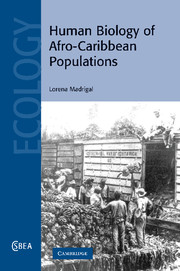Book contents
- Frontmatter
- Contents
- Foreword
- Acknowledgments
- 1 The African slave trade and the Caribbean
- 2 Obesity, hypertension, and non-insulin-dependent diabetes in Afro-Caribbean populations: an evolutionary overview
- 3 Infectious disease epidemiology and Afro-Caribbean populations
- 4 Population genetics of Afro-Caribbean groups
- 5 Demography of Afro-Caribbean groups
- 6 The Afro-Caribbean population in Limón, Costa Rica
- References
- Index
- References
Foreword
Published online by Cambridge University Press: 07 August 2009
- Frontmatter
- Contents
- Foreword
- Acknowledgments
- 1 The African slave trade and the Caribbean
- 2 Obesity, hypertension, and non-insulin-dependent diabetes in Afro-Caribbean populations: an evolutionary overview
- 3 Infectious disease epidemiology and Afro-Caribbean populations
- 4 Population genetics of Afro-Caribbean groups
- 5 Demography of Afro-Caribbean groups
- 6 The Afro-Caribbean population in Limón, Costa Rica
- References
- Index
- References
Summary
In the mid nineteenth century an American adventurer, diplomat, archaeologist, and newspaper editor (E. G. Squier, who wrote under the pseudonym of S. A. Bard), while exploring the Miskito coast of Honduras, described the Black Caribs living in the region as: “Most are pure Indians, not large, but muscular, with a ruddy skin, and long straight hair” (Bard, 1855, p.317). Similarly, British administrator, Thomas Young (1847, p.123), observed extensive variability among the Black Caribs: “some being coal black, others nearly as yellow as Saffron.”
In the 1970s, having read these graphic descriptions about the Black Caribs (also known as the Garifuna), I expected to see a Native American group similar to one I had observed earlier in Mexico. The Black Caribs originated on St. Vincent Island during the seventeenth century and, after a rebellion, were deported by the British to Roatan of the Bay Islands in 1798. In the following year, the Spanish transported the majority of the newly relocated Black Caribs from the Bay Islands to the coast of Central America. Almost 135 years later, when I arrived in Livingston, Guatemala (a sleepy Black Carib coastal village, nestled against the edge of a tropical forest), I was shocked to see a scene that could only have been “staged” in West Africa. The Garifuna were extremely dark with few morphological characteristics suggestive of Native American origins. They were trading in a market that could have been located anywhere along the Gold Coast of Africa.
- Type
- Chapter
- Information
- Human Biology of Afro-Caribbean Populations , pp. xi - xivPublisher: Cambridge University PressPrint publication year: 2006
References
- 1
- Cited by

